Witnesses encountered Fake Secret Service Agents in at least two locations in Dealy Plaza Immediatley after the shooting.
DPD Officer J M Smith encountered one behind the picket fence atop the grassy knoll.
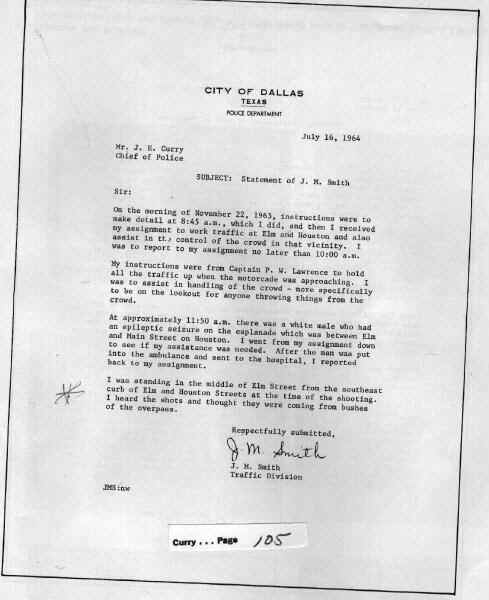
Below Volume VII-535.
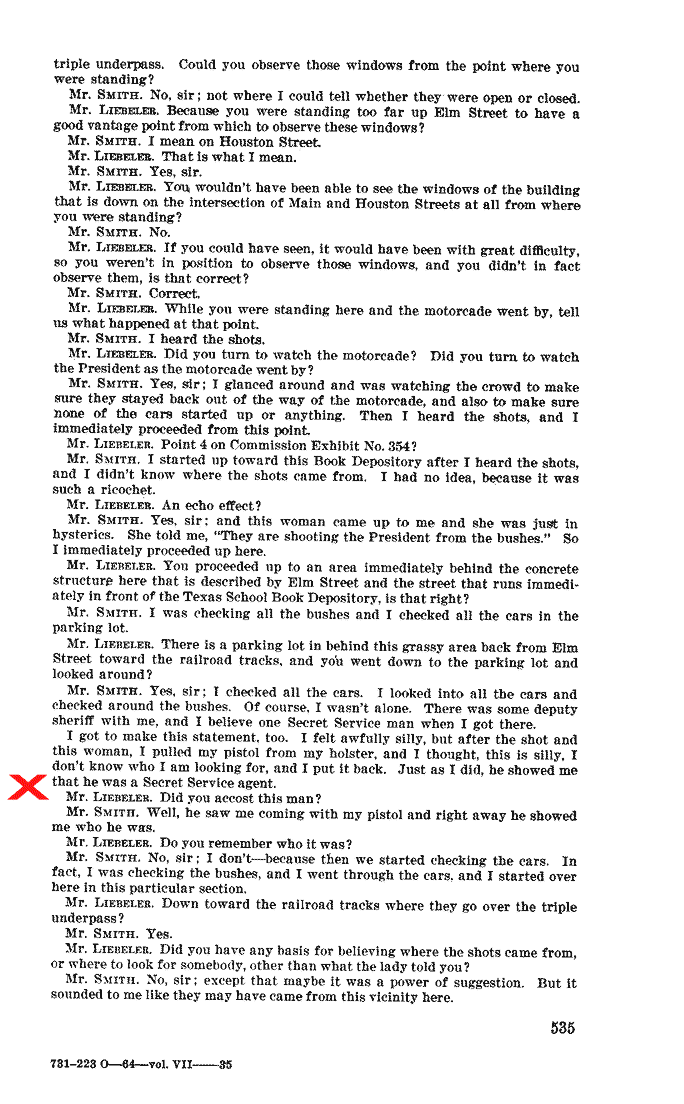
DPD Officer D V Harkness also met Fake Secret Service Agents.
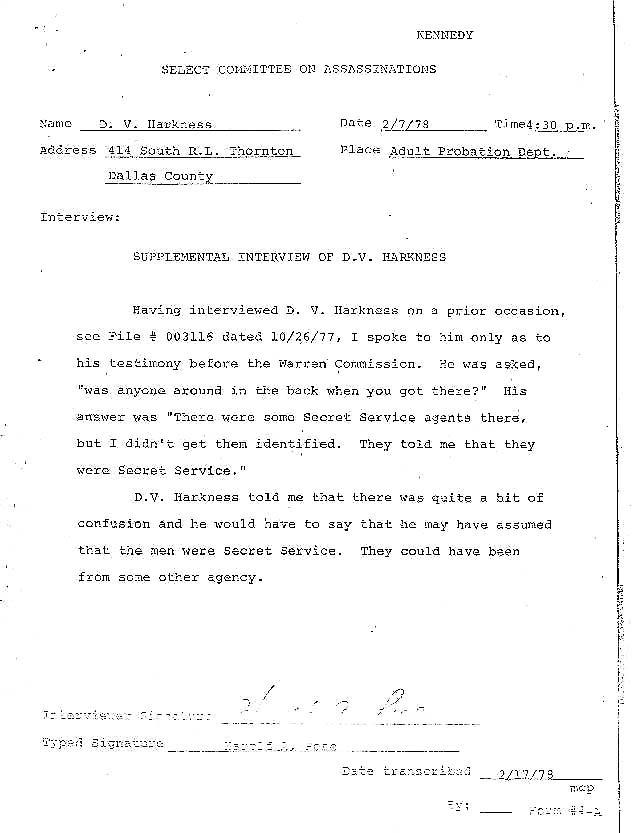
Below-Volume VI-312.
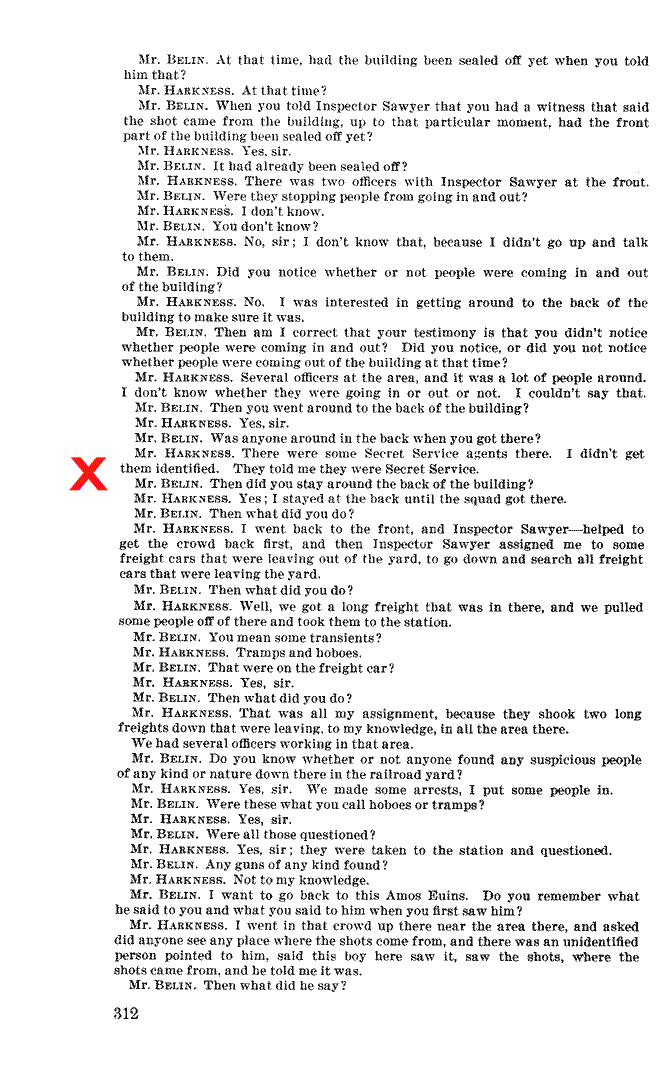
The Warren Report tells us that were NO Secret Service Agents on the ground in Dealy Plaza that day.
They were all in the motorcade & Stayed with the motorcade all the way to Parkland Hospital.
ALL Secret Service Agents working the President's visit were Identified by "Lapel Pins". (From DPD website)
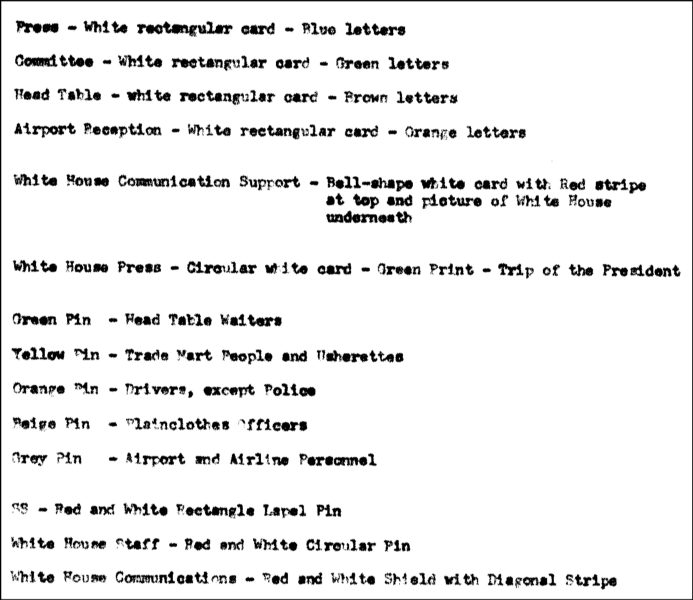
Those Lapel Pins CHANGED Shape/Color every day.
On 11/22/63 the Lapel Pins were Red/White Rectangular.
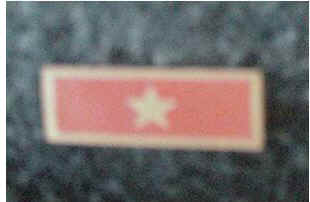
Those Lapel Pins were shown to every Dallas Officer who worked the Presidential visit to Dallas. From DPD Website below.
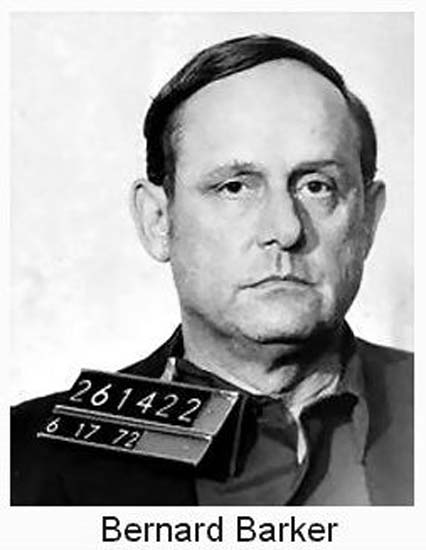
WATERGATE BURGLAR Bernard Barker behind the fence as S S Agent.
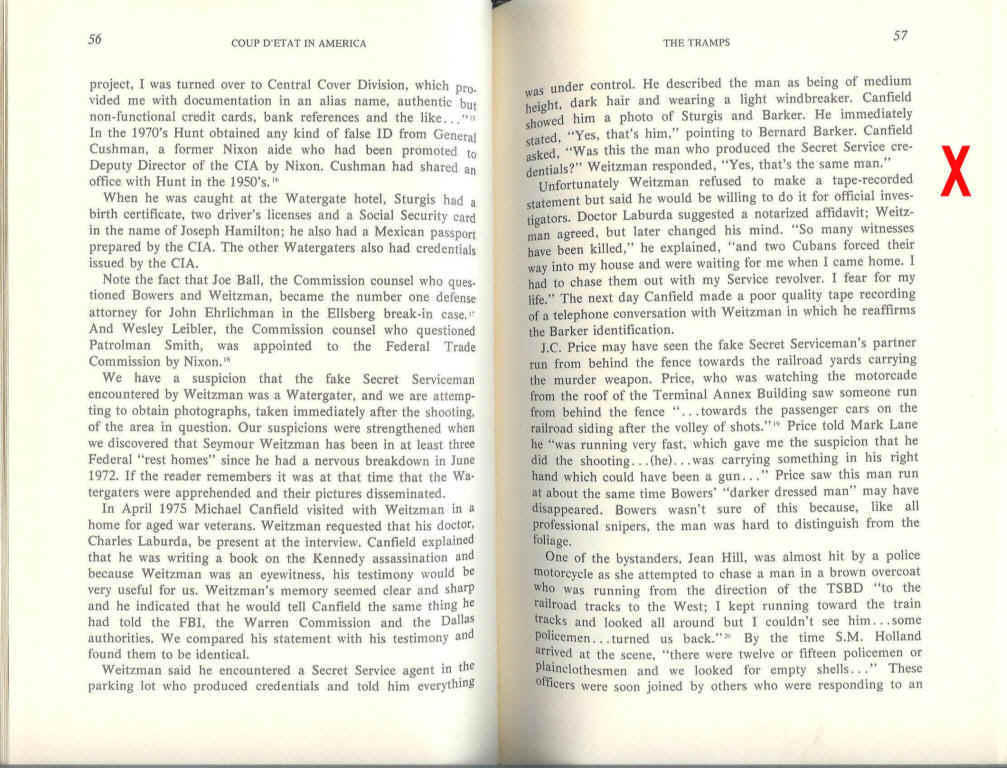

ADD SORRELS HERE
Forest Sorrels was the Head of the Dallas Secret Service.
Head of the Dallas Secret Service Forrest Sorrels encountered another fake Secret Service Agent at the back door of the TSBD after returning to the scene from Parkland Hospital 20/25 minutes later.
I will be adding Sorrels' testimony here shortly.
Each Agency had their Own I D systems. (see above)
THE MAN WHO WASN'T THERE,
WAS THERE
PHONY SECRET SERVICE AGENTS IN DEALEY PLAZA
Michael T. Griffith
1996@All Rights Reserved
Some witnesses said they encountered Secret Service agent in Dealey Plaza moments after the assassination. These reports continue to be the subject of much controversy. Why? Because it has long been established that no genuine Secret Service agents on the ground in Dealey Plaza until later that afternoon. This fact suggests phony Secret Service agents were in Dealey Plaza, and that they were there to help the assassins escape. David Scheim(1) summarizes:
"After the shooting, Dallas Police officer Joe M. Smith encountered another suspicious man in the lot behind the picket fence [on the grassy knoll]. Smith told the Warren Commission that when he drew his pistol and approached the man, the man "showed [Smith] that he was a Secret Service agent."
Another witness also reported encountering a man who displayed a badge and identified himself as a Secret Service agent. But according to Secret Service Chief James Rowley and agents at the scene, all Secret Service personnel stayed with the motorcade, as required by regulations, and none was stationed in the railroad parking lot [behind the grassy knoll]. It thus appeared that someone was carrying fraudulent Secret Service credentials--of no perceptible use to anyone but an escaping assassin. (Scheim 30-31)
Not only were there no Secret Service (SS) agents stationed on or behind the grassy knoll, but there were no FBI or other federal agents stationed there either. Officer Smith was not the only witness who encountered an apparently phony federal agent. Malcolm Summers ran to the knoll moments after the shooting. He related the following in the 1988 documentary Who Murdered JFK?:
"I ran across the--Elm Street to right there toward the knoll. It was there [pointing to a spot on the knoll]--and we were stopped by a man in a suit and he had an overcoat--over his arm and he, he, I saw a gun under that overcoat. And he--his comment was, "Don't you all come up here any further, you could get shot, or killed," one of those words. A few months later, they told me they didn't have an FBI man in that area. If they didn't have anybody, it's a good question who it was. " (Anderson 14)
|
"Don't you all come up here any further, you could get shot, or killed..."
|
Lone-gunman theorist Gerald Posner dismisses all reports of phony SS agents:
"Outside the Depository, some witnesses later claimed they ran into Secret Service agents. Since there were no Secret Service agents at Dealey until 1:00 P.M., when Forrest Sorrels returned from Parkland Hospital, could that mean that somebody was impersonating Secret Service agents, indicating a conspiracy? Most of the witnesses later admitted they were mistaken. And immediately after the assassination, different groups of law enforcement officials (most of them having been there to watch the motorcade from nearby government buildings) spread out in Dealey Plaza--they included Alcohol, Tobacco and Firearms (ATF) agents, postal inspectors, officers from the Special Service Bureau of the Dallas Police, county sheriffs, IRS agents, and even an Army intelligence agent. . . . The author has reviewed the 1963 badges for the above organizations, and found that several look alike. Any of those law enforcement officials could have been confused with Secret Service agents. " (Posner 269)
I find this explanation inadequate for a number of reasons. For one thing, the various "spectator" government agents mentioned by Posner could not have reached the parking lot behind the grassy knoll so quickly after the shooting; none of them could have been there in time to be encountered by Officer Smith. Furthermore, although Officer Smith did not specifically say so, it seems reasonable to infer from his testimony that the man he met identified himself VERBALLY as an SS agent--I doubt that the man merely held up his badge and said nothing. In addition, Posner does not address the fact that Officer Smith himself later became suspicious of the man he had seen, nor does Posner mention Smith's reasons for doubting the man's identity. Explained Officer Smith:
He looked like an auto mechanic. He had on a sports shirt and sports pants. But he had dirty fingernails, it looked like, and hands that looked like an auto mechanic's hands. And afterwards it didn't ring true for the Secret Service. At the time we were so pressed for time, and we were searching. And he had produced correct identification, and we just overlooked the thing. I should have checked that man closer, but at the time I didn't snap on it. (Summers 50)
Former Dallas Police Chief Jesse Curry stated in 1977 that the man encountered by Officer Smith "must have been bogus." Said Curry,
"I think he must have been bogus--certainly the suspicion would point to the man as being involved, some way or other, in the shooting since he was in an area immediately adjacent to where the shots were--and the fact that he had a badge that purported him to be Secret Service would make it seem all the more suspicious." (Summers 51)
As for Smith's account, Posner notes that Smith said nothing about encountering an armed federal agent in his 11/22/63 affidavit (Posner 259). But this is understandable, since Smith had no reason at the time to think it was unusual or noteworthy that an armed federal agent would be stationed on the grassy knoll. He apparently assumed that the man was an FBI agent. It wasn't until later that Smith learned no FBI agents were stationed in that area before or after the shooting.
Posner further notes that "no one else saw" the man Smith said he encountered. However, even if no one else saw the man, this does not prove that Smith's account is false. Nor can we be absolutely certain that no one else saw the man. The most that can be said is that is no known report is available that another witness saw him.
Often overlooked in discussions on phony SS agents in Dealey Plaza is the disturbing account of Sergeant D. V. Harkness, (Posner, for example, does not even mention it.). Sergeant Harkness went to the REAR of the Texas School Book Depository Building within a few minutes of the assassination. When he arrived there, he encountered several "well-armed" men dressed in suits. These "well-armed" men TOLD Harkness they were SS agents (Hurt 110-111). It's not hard to understand why the presence of the armed, well-dressed men at the rear of the Book Depository did not make Harkness suspicious. Police officers were beginning to seal off the area, and just six minutes after the shooting Harkness himself identified the Depository over the radio as a possible source of gunfire. The problem, of course, is that the men encountered by Harkness could not have been legitimate SS agents, nor is it credible to suggest that Harkness somehow "misunderstood" what they said to him.
Did Officer Smith Encounter A Real Secret Service Agent?
Having just read Chris Mills' article "The Man Who Wasn't There" in the December 1995 issue of The Assassination Chronicles (pp. 58-62), I would like to note some of the weaknesses that I see in his theory. Mills believes that Secret Service agent Thomas "Lem" Johns was the man encountered by Officer Smith. I realize that Mills believes that if his theory is correct, it constitutes evidence that Johns believed shots came from the knoll. However, I have several problems with Mills' theory:
![]() I
find Mills' explanation of Smith's statement about the man's clothing to be
unconvincing. Mills simply dismisses the statement, partly on the basis that it
was made fifteen years later, "by which time Smith was well aware of the
controversy his original statement had caused." What is Mills saying here? That
Smith embellished his story because he knew how much controversy his original
account had caused? But wouldn't Smith have therefore watered down the account,
instead of adding troubling features to it? In essence, Mills is saying that
either Smith's memory was egregiously mistaken or he deliberately embellished
his story.
I
find Mills' explanation of Smith's statement about the man's clothing to be
unconvincing. Mills simply dismisses the statement, partly on the basis that it
was made fifteen years later, "by which time Smith was well aware of the
controversy his original statement had caused." What is Mills saying here? That
Smith embellished his story because he knew how much controversy his original
account had caused? But wouldn't Smith have therefore watered down the account,
instead of adding troubling features to it? In essence, Mills is saying that
either Smith's memory was egregiously mistaken or he deliberately embellished
his story.
![]() Mills
goes on to note that Officer Smith did not mention that the man was wearing a
sports shirt in his WC testimony. This omission however, proves nothing. Smith
recounted in his testimony that he had seen other law enforcement officers in
civilian clothes, i.e., not in their normal attire, right after the shooting.
So, at the time, Smith could have assumed that the man was an SS agent in casual
civilian clothes, and thus would have had no reason to mention that the man was
wearing a sports shirt (and sports pants). And what about the fact that Officer
Smith also said the man was wearing sports pants? Mills does not address this
point.
Mills
goes on to note that Officer Smith did not mention that the man was wearing a
sports shirt in his WC testimony. This omission however, proves nothing. Smith
recounted in his testimony that he had seen other law enforcement officers in
civilian clothes, i.e., not in their normal attire, right after the shooting.
So, at the time, Smith could have assumed that the man was an SS agent in casual
civilian clothes, and thus would have had no reason to mention that the man was
wearing a sports shirt (and sports pants). And what about the fact that Officer
Smith also said the man was wearing sports pants? Mills does not address this
point.
![]() Mills
deals with Smith's recollection that the man had dirtied hands by suggesting
that Johns had dirtied his hands between exiting the car and allegedly meeting
Smith ("on the fence, dusty cars, etc."). But would Johns' hands have become so
noticeably dirty that Smith would describe them as "hands like a mechanic"? This
statement implies that the hands were quite dirty, with dirt or grease readily
visible on them. What's more, no evidence exists that Johns jumped over the
picket fence to get behind it, assuming he was ever behind the fence at all. (In
fact, no evidence whatsoever exists that Johns went behind the fence.) Would the
fence have been THAT dirty anyway? And why would Johns have touched any cars?
Even assuming he casually put his hands--not just one hand, but both hands--on a
few cars, were these cars so dusty that they could have dirtied someone's hands
to the point that they would be described as looking like a mechanic's hands?
Would Johns' hands have been markedly dirty after hurriedly jumping the fence
and then touching a few cars? I don't think so.
Mills
deals with Smith's recollection that the man had dirtied hands by suggesting
that Johns had dirtied his hands between exiting the car and allegedly meeting
Smith ("on the fence, dusty cars, etc."). But would Johns' hands have become so
noticeably dirty that Smith would describe them as "hands like a mechanic"? This
statement implies that the hands were quite dirty, with dirt or grease readily
visible on them. What's more, no evidence exists that Johns jumped over the
picket fence to get behind it, assuming he was ever behind the fence at all. (In
fact, no evidence whatsoever exists that Johns went behind the fence.) Would the
fence have been THAT dirty anyway? And why would Johns have touched any cars?
Even assuming he casually put his hands--not just one hand, but both hands--on a
few cars, were these cars so dusty that they could have dirtied someone's hands
to the point that they would be described as looking like a mechanic's hands?
Would Johns' hands have been markedly dirty after hurriedly jumping the fence
and then touching a few cars? I don't think so.
|
"The logical
assumption is that Agent Johns showed up for duty |
![]() It
should also be pointed out that Smith noted that the man's fingernails were
dirty as well. It is this kind of specific detail that, in my opinion, gives
Smith's account to Summers the ring of truth. And, if the mystery man was Agent
Johns, how could he have so dirtied his fingernails that they would be
noticeably dirty to a policeman during a brief encounter? The logical assumption
is that Agent Johns showed up for duty that morning properly cleaned and
groomed. After all, he was about to participate in a presidential motorcade. The
idea that he would have reported for duty with noticeably dirty fingernails
strikes me as highly unlikely. Could he have dirtied his fingernails during the
motorcade? It is hard to see how he could have done so, since all he was doing
was riding in a car. Even assuming that he touched a dirty seat or something,
would that have so soiled his fingernails as to make them visibly dirty? Such a
scenario is extremely improbable.
It
should also be pointed out that Smith noted that the man's fingernails were
dirty as well. It is this kind of specific detail that, in my opinion, gives
Smith's account to Summers the ring of truth. And, if the mystery man was Agent
Johns, how could he have so dirtied his fingernails that they would be
noticeably dirty to a policeman during a brief encounter? The logical assumption
is that Agent Johns showed up for duty that morning properly cleaned and
groomed. After all, he was about to participate in a presidential motorcade. The
idea that he would have reported for duty with noticeably dirty fingernails
strikes me as highly unlikely. Could he have dirtied his fingernails during the
motorcade? It is hard to see how he could have done so, since all he was doing
was riding in a car. Even assuming that he touched a dirty seat or something,
would that have so soiled his fingernails as to make them visibly dirty? Such a
scenario is extremely improbable.
![]() Mills
suggests that Wiegman and Johns were behind the picket fence at the same time.
But Wiegman said nothing about going behind the fence. Instead, his account
strongly indicates that he and Agent Johns were near or behind the end of the
western wall of the pergola. Also, Wiegman didn't say anything about Johns being
challenged (or even approached) by a police officer, nor about Johns' then
producing Secret Service ID in response, and Smith, in turn, said nothing about
an unknown man (i.e., Wiegman) being next to or near the man he challenged.
Mills
suggests that Wiegman and Johns were behind the picket fence at the same time.
But Wiegman said nothing about going behind the fence. Instead, his account
strongly indicates that he and Agent Johns were near or behind the end of the
western wall of the pergola. Also, Wiegman didn't say anything about Johns being
challenged (or even approached) by a police officer, nor about Johns' then
producing Secret Service ID in response, and Smith, in turn, said nothing about
an unknown man (i.e., Wiegman) being next to or near the man he challenged.
![]() When
Wiegman stopped filming and ran down the knoll to reach his car, Johns might
have already been on the street (see Richard Trask, Pictures Of The Pain,
p. 374). Said Wiegman, When I came back down the hill Lem Johns didn't have a
ride and I said, 'Come on, get in our car. Here it is." " This statement seems
to imply that when Wiegman came back down from the knoll and approached his car
on the street, Johns was already nearby. If such was the case, are we to believe
that Johns just happened to come down from the knoll in time to be near the road
when Wiegman approached his car?
When
Wiegman stopped filming and ran down the knoll to reach his car, Johns might
have already been on the street (see Richard Trask, Pictures Of The Pain,
p. 374). Said Wiegman, When I came back down the hill Lem Johns didn't have a
ride and I said, 'Come on, get in our car. Here it is." " This statement seems
to imply that when Wiegman came back down from the knoll and approached his car
on the street, Johns was already nearby. If such was the case, are we to believe
that Johns just happened to come down from the knoll in time to be near the road
when Wiegman approached his car?
![]() However,
one could also read Wiegman's account to mean that Johns accompanied Wiegman
back down the slope. We know from Wiegman's account that he and Johns were
fairly close to each other when they were near or behind the end of the western
wall of the pergola. It is not illogical to suppose that Johns followed Wiegman
down the hill and that Wiegman then offered him a ride in the camera car.
However,
one could also read Wiegman's account to mean that Johns accompanied Wiegman
back down the slope. We know from Wiegman's account that he and Johns were
fairly close to each other when they were near or behind the end of the western
wall of the pergola. It is not illogical to suppose that Johns followed Wiegman
down the hill and that Wiegman then offered him a ride in the camera car.
![]() If
Agent Johns had been in the parking lot, presumably he would have been in the
act of searching, and this action would have been obvious to anyone who saw him.
Why, then, would Officer Smith have even approached him? What's more, Johns was
wearing a coat and tie, which makes it even harder to understand why Officer
Smith would have approached him if he had been the man in question.
If
Agent Johns had been in the parking lot, presumably he would have been in the
act of searching, and this action would have been obvious to anyone who saw him.
Why, then, would Officer Smith have even approached him? What's more, Johns was
wearing a coat and tie, which makes it even harder to understand why Officer
Smith would have approached him if he had been the man in question.
![]() Confronted
with the fact that Agent Johns said nothing in his report (or later) about being
challenged behind the fence by a police officer, Mills suggests that Johns
omitted this event because he was embarrassed over having become separated from
Vice President Johnson and/or because his actions indicated he believed shots
came from the right front. But why would Johns have remained silent in
subsequent years when Warren Commission critics repeatedly and loudly pointed to
Smith's encounter as evidence that a phony SS man was stationed on the knoll?
And, was Johns alive during the House investigation? If so, given the attention
that Smith's encounter received during that inquiry, wouldn't Johns have come
forward to clear up the matter then? If Johns had been the man Smith saw, one
would think that Johns would have shared this historic fact with at least a few
of his closest friends and family, and, if this were the case, surely one of
them would have long since disclosed this information by now.
Confronted
with the fact that Agent Johns said nothing in his report (or later) about being
challenged behind the fence by a police officer, Mills suggests that Johns
omitted this event because he was embarrassed over having become separated from
Vice President Johnson and/or because his actions indicated he believed shots
came from the right front. But why would Johns have remained silent in
subsequent years when Warren Commission critics repeatedly and loudly pointed to
Smith's encounter as evidence that a phony SS man was stationed on the knoll?
And, was Johns alive during the House investigation? If so, given the attention
that Smith's encounter received during that inquiry, wouldn't Johns have come
forward to clear up the matter then? If Johns had been the man Smith saw, one
would think that Johns would have shared this historic fact with at least a few
of his closest friends and family, and, if this were the case, surely one of
them would have long since disclosed this information by now.
![]() The
Select Committee investigated Smith's story and determined that no SS men were
behind the picket fence at the time of the encounter (Blakey 101).
The
Select Committee investigated Smith's story and determined that no SS men were
behind the picket fence at the time of the encounter (Blakey 101).
![]() From
my reading of Smith's and Wiegman's accounts, I seriously doubt that Johns could
have been in the parking lot behind the grassy knoll at the time Smith
encountered the man with dirty hands wearing a sports shirt and sports pants.
From
my reading of Smith's and Wiegman's accounts, I seriously doubt that Johns could
have been in the parking lot behind the grassy knoll at the time Smith
encountered the man with dirty hands wearing a sports shirt and sports pants.
![]() Mills
assumes that Johns could have been the man seen by Officer Smith because Johns
does not appear in certain photos of the knoll. However, the photographic record
of the knoll during the time in question is neither continuous nor complete.
Agent Johns could have been just out of sight a little farther north on Elm
Street. Or, he could have been behind the end of the western wall of the
pergola. Wiegman's account clearly indicates that he saw Johns in this general
area, either near the end of the wall or just behind it--or both, for that
matter, though obviously not at the same time (Trask 372-373). But, this account
is a far cry from getting Johns in the parking lot, much less getting him there
in time to be seen and then challenged by Officer Smith.
Mills
assumes that Johns could have been the man seen by Officer Smith because Johns
does not appear in certain photos of the knoll. However, the photographic record
of the knoll during the time in question is neither continuous nor complete.
Agent Johns could have been just out of sight a little farther north on Elm
Street. Or, he could have been behind the end of the western wall of the
pergola. Wiegman's account clearly indicates that he saw Johns in this general
area, either near the end of the wall or just behind it--or both, for that
matter, though obviously not at the same time (Trask 372-373). But, this account
is a far cry from getting Johns in the parking lot, much less getting him there
in time to be seen and then challenged by Officer Smith.
|
"Are we also to
assume that Smith would not have approached |
![]() Mills'
theory appears to be refuted by the photographic evidence. Photos and film
footage taken by Wiegman, Malcolm Couch, and Richard Bothun, for example,
indicate that Wiegman's press car left the plaza--WITH AGENT JOHNS IN IT--no
more than 60-70 seconds after the final shot, and possibly as early as 45-55
seconds afterward (cf. Trask 156-157, 374-376, 426-427). Bothun photo 4 was
taken about 30 seconds after the last shot. In it we see Wiegman pointing his
camera at an oncoming patrolman, Clyde Haygood. This was AFTER Wiegman had
filmed the Newmans and the Hesters (Trask 157). Wiegman stopped filming a few
seconds later. Then, about 15-20 seconds after that, Wiegman raced to catch his
car after running down the grassy slope toward another woman who was lying on
the ground (Trask 374)
Mills'
theory appears to be refuted by the photographic evidence. Photos and film
footage taken by Wiegman, Malcolm Couch, and Richard Bothun, for example,
indicate that Wiegman's press car left the plaza--WITH AGENT JOHNS IN IT--no
more than 60-70 seconds after the final shot, and possibly as early as 45-55
seconds afterward (cf. Trask 156-157, 374-376, 426-427). Bothun photo 4 was
taken about 30 seconds after the last shot. In it we see Wiegman pointing his
camera at an oncoming patrolman, Clyde Haygood. This was AFTER Wiegman had
filmed the Newmans and the Hesters (Trask 157). Wiegman stopped filming a few
seconds later. Then, about 15-20 seconds after that, Wiegman raced to catch his
car after running down the grassy slope toward another woman who was lying on
the ground (Trask 374)
![]() So
Bothun photos 4 suggests that Wiegman's car left the plaza about 50-65 seconds
after the shooting. In the Couch film we see what appears to be Agent Johns and
newsman Tom Atkins running to the street to catch a ride, and Johns is seen to
vault over the trunk of Wiegman's camera car (Trask 425-427). When did Couch
capture this scene on film? Approximately 45-65 seconds after the last shot was
fired. In short, Johns did not have enough time to do all the things required of
him by Mills' theory. Richard Trask has reached the same conclusion, as Mills
candidly acknowledges in a footnote.
So
Bothun photos 4 suggests that Wiegman's car left the plaza about 50-65 seconds
after the shooting. In the Couch film we see what appears to be Agent Johns and
newsman Tom Atkins running to the street to catch a ride, and Johns is seen to
vault over the trunk of Wiegman's camera car (Trask 425-427). When did Couch
capture this scene on film? Approximately 45-65 seconds after the last shot was
fired. In short, Johns did not have enough time to do all the things required of
him by Mills' theory. Richard Trask has reached the same conclusion, as Mills
candidly acknowledges in a footnote.
To judge from the available evidence, Officer Smith encountered the mystery man--again, keep in mind, in the parking lot behind the knoll--about 25-40 seconds after the shots were fired. Smith indicated the man was already among the cars when he saw him (Summers 50). Not only was the man already there, but the man apparently did not rush off right after the encounter, as Johns would have had to do in order to catch his ride with Wiegman. If the man had suddenly run off, one would think Smith would have mentioned this in his WC testimony or in his interview with Summers. After the man showed Smith what appeared to be Secret Service identification, Smith continued to search among the cars. The logical implication is that the man remained in the parking lot for a while. In addition, it stands to reason that the mystery man did not suddenly arrive to the parking lot just a few seconds before Officer Smith saw him, since one would suspect that Smith would have mentioned this as well.
In other words, it seems reasonable to assume that the man was in the parking lot well before Smith began to search around the cars. Moreover, Officer Smith's encounter with the mystery man appears to have occurred at roughly the same time that Wiegman saw Agent Johns near the end of the western wall of the pergola. The parking lot was a good 40 feet from this area and was separated from it by the picket fence.
Michael T. Griffith, 1996
Bibliography
(1) All subsequent references are listed below in alphabetical order:
Anderson, Jack, American Expose: Who Murdered JFK?, New York: Journal Graphics' Transcript, 1988.
Blakey, G. Robert and Richard Billings, Fatal Hour, Berkley Books Edition, New York: Berkley Books, 1992.
Hurt, Henry, Reasonable Doubt: An Investigation Into The Assassination Of John F. Kennedy, New York: Holt, Rinehart, and Winston, 1985.
Posner, Gerald, Case Closed: Lee Harvey Oswald And The Assassination Of JFK, New York: Random House, 1993.
Scheim, David, The Mafia Killed President Kennedy, London: Virgin Books, 1988.
Summers, Anthony, Conspiracy: The Definitive Book On The JFK Assassination, Updated and Expanded Edition, New York: Paragon House, 1989.
below is what author gerald posner wrote>>>
I can be reached for Questions, Comments, Files Transfers or, Clarifications at the following e-mail address.
